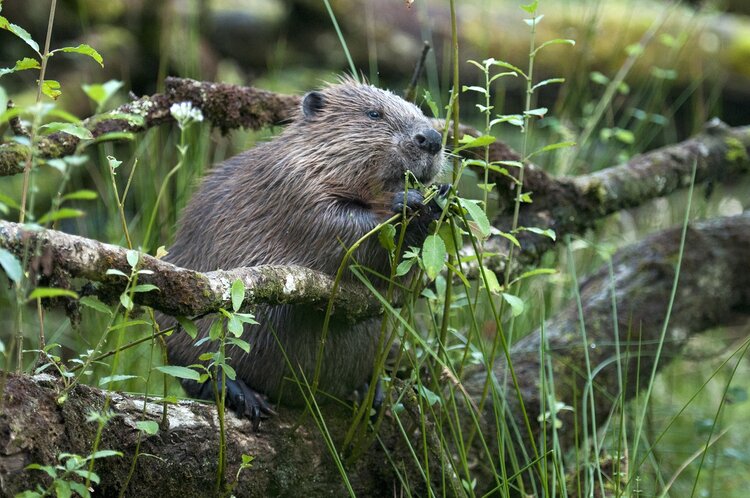While some species have very little influence on their ecosystems, keystone species have a disproportionately large impact on them relative to their abundance. Keystone species can be a whole range of things, including predator or prey, ecosystem engineers (modify landscape instead of the food supply directly), and mutualists (two or more species that interact reciprocally). Here are five different keystone species that you may or may not be aware of!
- The ochre starfish is found in tidal pools around Northwestern North America. This keystone predator was the first ever “keystone” species, as named by the ecologist Robert Paine. He wanted to compare two areas of shoreline so removed starfish from one area. He then observed that despite being relatively uncommon, the sea stars had a huge impact on biodiversity. Due to the lack of predatory sea stars mussels quickly outcompeted many other species including sponges, algae, limpets and anemones. Within one year the biodiversity of the ecosystem was halved, showing that the ochre starfish had been playing a crucial role in the ecosystem.
- Beavers dramatically alter the physical landscape rather than directly impacting the food chain itself. The dams that they construct flood the landscape and form a wetland habitat which can support a huge diversity of species. Groups such as freshwater fish, amphibians, invertebrates, birds, plants and more rely on wetlands for breeding grounds, feeding, shelter and more. The dams have also been shown to catch impurities in the water and so improve water quality, as well as reduce flooding, reduce water shortages and reduce erosion of stream banks. Beavers are key ecosystem engineers and make huge impacts on ecosystems.

- Wolves are probably the most famous example of a keystone species. Historically there was a thriving population in Yellowstone National Park, however they were killed off in the 1920s. Once they were removed it became abundantly clear that the grey wolves were playing an essential role in the ecosystem. Without the dominant predator elk populations began to rise, but so did overgrazing on aspen and willow. Beavers commonly used willow stands for creating their dams however struggled to do so with the depleted willow tree abundance. This meant that beavers began disappearing, and so did their dams. As mentioned above, beavers’ dams have a huge impact on water quality and erosion of stream banks, so the biodiversity of the streams rapidly diminished. With the lack of big predators there was a lack of carrion, so scavenger numbers reduced too. The park rangers were concerned about this loss of biodiversity and so grey wolves have now been reintroduced to the reserve. The removal of this one species had a far greater impact on such a huge range of species than anyone would have guessed.
- Bees and other pollinators together support the reproduction of 90% of the planet’s flowering planets. Without bees there would be a bottom-up cascade of consequences throughout the food chain. Interestingly, honey bees are also considered a keystone species because of the pathogen resistance that their products (honey, beeswax etc.) can confer to other organisms! Sadly, worldwide bees are under threat from pesticides, habitat loss and disease. This could have catastrophic consequences for plant diversity and all of the other species that rely on those plants.
- African elephants living on the savannahs of East and Southern Africa are a keystone species largely because they can consume upwards of 100kg of vegetation in a single day. They can eat and uproot small trees and scrub that could otherwise continue growing and become forest. They are keystone species because they preserve the large open spaces where grasses can grow and this supports other large herbivores such as zebras, antelopes and wildebeests. The open sunny spaces also provide warm, dry soil which is ideal for the burrows of small mammals and in turn these are preyed on by carnivores. The other way that elephants are important is that they spread plant seeds to new areas in their dung when they roam. Some plants have evolved to have seeds that germinate more easily after passing through an elephant’s digestive system!

Photo by Katherine Kelsey
In ecosystems where a keystone species is missing we then class them as “downgraded” because the systems don’t function properly without that species. For this reason the reintroduction of missing keystone species is an important part of increasing biodiversity and abundance of species.
In the UK we are missing many ecosystem drivers such as wolves, lynx, bison, wild horse and beavers, though there are now reserves and rewilding projects across the UK that are aiming to reintroduce them (or mimics) to attempt to improve biodiversity and species abundance. Domestic breeds of cattle, ponies and pigs have been introduced to roam naturally to replicate the impacts of wild boar, wild ponies and aurochs. A great example of this is Knepp, a rewilding site where Opwall run field courses! People can also play a role in emulating natural processes by coppicing trees like elk, culling deer like lynx or wolves and build leaky dams like beavers.
All of these processes can improve soil quality, water quality and biodiversity, however long-term the only true way to repair our ecosystems is to reintroduce those species. In the UK a brilliant example of this is the many sites trialing beaver introductions. There are also some groups pushing for lynx introductions into Scotland too.
Keystone species are integral to functioning ecosystems and if they are missing then it affects many other species. Understanding their importance is key (see what I did there?) to maintaining healthy ecosystems.




Social Media Links